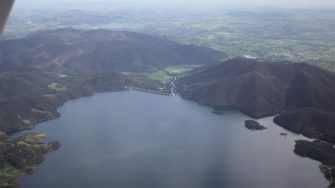
Date: Tuesday, November 1, 2016
Project: Eastern Australian Waterbird Survey
Observer: Richard Kingsford
We left early to get to Albury and start surveying the River Murray. On the way, we flew past Lake George again, not one of the wetlands we survey but such a huge lake.
Lake George just north of Canberra
After Canberra, we flew over the mountains, past the full Blowering Dam on the Tumut River, which diverts water through the Snowy Mountains Scheme, into the Murrumbidgee River for irrigation at Colleambally.
Blowering Dam on the Tumut River
Today we got half-way down the River Murray, as far as Mildura. Over the next three weeks, we are surveying all of the major wetlands in the Murray-Darling Basin for the Murray-Darling Basin Authority. This contributes to our ongoing understanding of trends and also measuring the effects of the environmental flow, under the Basin plan. Just south of Albury, it was soon very clear just how much water had been in this river. You could see all the billabongs beside the river had filled from the floods.
The upper River Murray with its billabongs full from the last flood
West of the town of Corowa, the site of a major water conference for the southern states in their dispute about the water of the River Murray in 1902, we surveyed Lake Mulwala, which is the pool backed up by Yarrawonga Weir. This ‘large dam’ has killed the river red gums that were once along the river through water-logging. It usually has a few cormorants, pelicans and swans but there were fewer waterbirds than we had previously seen, apart from a small pelican colony on an island.
Water ‘pooled’ by Yarrawonga Weir
From here, we kept heading west along the river, until we reached the huge Barmah-Millewa Forest. The Barmah is on the Victorian side while the Millewa is on the NSW side, with the River Murray the border in between. River red gums stretch in every direction. At 66,000 hectares, it is the largest river red gum forest in Australia, with great biodiversity value http://theconversation.com/unknown-wonders-barmah-millewa-forest-13522. It has many lagoons, reedbeds and lakes. Altered flow regimes have considerably degraded the forest, changing its vegetation and waterbird communities. Today it was flooding over the banks of the River Murray into the forest. The water glistened to us as we used five 200m wide transects, running north to south, surveying the waterbirds in the red gums. It is such a massive area and highly productive when wet.
Flooded Barmah-Millewa River red gum forest
Once we had done our five transects, which took us well over an hour, we weaved back and forth through the wetlands of the Barmah-Millewa Forest: the lagoons, marshes, reed swamps and lakes. There weren’t many waterbirds but two of reedbes had colonies of white ibis, straw-necked ibis and royal spoonbills, perhaps as many as a thousand. The pattern here was as everywhere – waterbirds thinly spread but breeding.
Surveying an ibis and spoonbill colony in a reedbed
Surveying Moira Lake (bug on the lens)
Next on our survey list was the Gunbower-Koondrook-Pericoota, another extensive river red gum forest. Water in every direction under the river red gums. It wasn’t as wet as the Barmah-Millewa but great to see. We also had to run five north-south transects across the forest to cover it.
Our final survey area was the Hattah Lakes. This string of lakes was significantly compromised by river regulation with the river needing to get to high levels before the inflowing creeks would run to fill the lakes. Given the reductions in flows in the rivers, engineering works were needed to put water into the lakes for some sustainability (http://www.malleecma.vic.gov.au/about-us/programs/rivers-and-wetlands/hattah-lakes.html ). Today, the lakes were all full and overflowing. We hadn’t seen water levels so high in this string of lakes which were all connected. It was a challenge to navigate but hardly any waterbirds.
